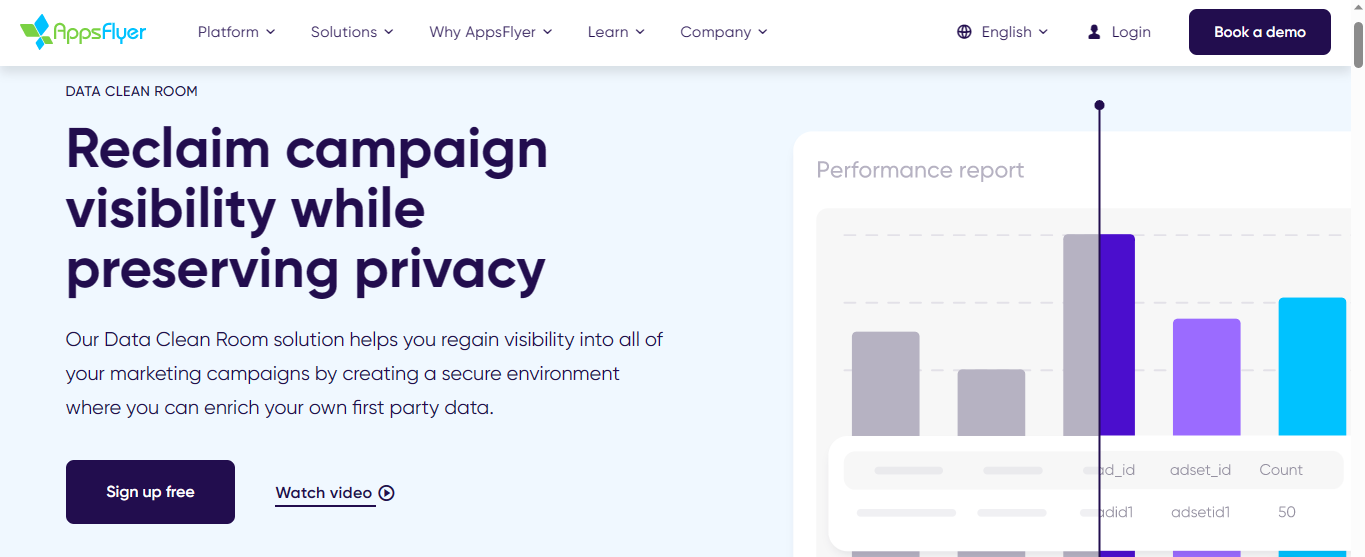
Page Contents
Introduction
In today’s digital world, data has become the most valuable asset for businesses of all sizes. With the growth of digital marketing and mobile apps, companies are collecting an enormous amount of data on their customers. This data can be used to gain insights into customer behavior, preferences, and purchasing habits, which can be leveraged to drive business growth.
However, with great power comes great responsibility. Companies are under immense pressure to protect their customer’s privacy and ensure that their data is not misused. This is where AppsFlyer Data Clean Room comes into play and this article helps you discover the benefits and risks of AppsFlyer Data Clean Room. You also learn how this technology enables secure data collaboration between businesses, agencies, and partners while preserving data privacy and complying with data privacy regulations.
.
What is AppsFlyer Data Clean Room?
Source Link: https://images.app.goo.gl/uoxh9zfgho9mk4ZA6
AppsFlyer Data Clean Room is a data collaboration solution that enables secure and privacy-preserving data collaboration between different parties. The solution is designed to help businesses share data with partners or agencies without compromising data privacy and security.
The data clean room is essentially a secure and isolated environment where data can be uploaded, stored, and analyzed without revealing any personally identifiable information (PII). This is achieved through a combination of advanced cryptographic techniques and strict data access controls.
Let’s take a closer look at how the AppsFlyer Data Clean Room works and its benefits.
How does the AppsFlyer Data Clean Room work?
The AppsFlyer Data Clean Room is a cloud-based solution that operates in a multi-party environment. In a typical data clean room setup, two or more parties who want to collaborate on a project agree to share their data in the data clean room.
Once the parties agree to share their data, they upload their data to the data clean room. The data is stored in an encrypted format, which means that only authorized users have access to it. The data is then processed and analyzed within the data clean room, where it can be used to gain insights and make data-driven decisions.
However, the key benefit of the AppsFlyer Data Clean Room is that the parties who share their data never have access to the raw data itself. Instead, they work with statistical representations of the data, such as summary statistics, aggregates, and correlations.
This means that each party can maintain the privacy and security of their data while still benefiting from the insights and analysis that can be gained through data collaboration. It also ensures that there is no risk of data misuse or data leakage, as the raw data is never shared outside of the data clean room.
Benefits of using the AppsFlyer Data Clean Room
The AppsFlyer Data Clean Room offers a range of benefits for businesses that want to collaborate on data projects. Here are some of the key benefits:
- Improved data privacy and security
One of the most significant benefits of the AppsFlyer Data Clean Room is that it offers a high level of data privacy and security. By using advanced cryptographic techniques and strict data access controls, the data clean room ensures that data is not misused or compromised.
- Data collaboration without data sharing
The AppsFlyer Data Clean Room enables data collaboration without the need for data sharing. This means that each party can maintain control over their data while still benefiting from the insights and analysis that can be gained through collaboration.
- Enhanced data insights
By collaborating on data projects, businesses can gain insights that they would not have been able to gain on their own. The AppsFlyer Data Clean Room enables businesses to combine their data with that of their partners or agencies, which can lead to a deeper understanding of customer behavior and preferences.
- Cost-effective data collaboration
Collaborating on data projects can be expensive, as it often requires significant resources and expertise. The AppsFlyer Data Clean Room offers a cost-effective solution to data collaboration, as it eliminates the need for businesses to invest in expensive infrastructure or data analysis tools.
- Compliance with data privacy regulations
Businesses are under increasing pressure to comply with data privacy regulations, such as GDPR and CCPA. The AppsFlyer Data Clean Room helps businesses comply with these regulations by ensuring that data is handled in a secure and privacy-preserving manner.
- Increased Business Agility
The AppsFlyer Data Clean Room enables businesses to collaborate on data projects quickly and efficiently. This can lead to increased business agility, as businesses can make data-driven decisions faster and more effectively.
- Improved Data Quality
Collaborating on data projects can help businesses improve the quality of their data by identifying errors or gaps in their data sets. By combining data from multiple sources, businesses can create more comprehensive and accurate data sets, which can lead to better insights and decision-making.
Risks Associated with AppsFlyer Data Clean Room
While the AppsFlyer Data Clean Room offers several benefits, there are also some risks associated with using this technology. Here are some of the key risks to consider:
- Data Quality Risks
One of the risks associated with using the AppsFlyer Data Clean Room is that data quality may be compromised. When multiple data sets are combined, there is a risk that errors or inconsistencies in the data may not be identified, leading to inaccurate analysis and decision-making.
- Misuse of Data
While the AppsFlyer Data Clean Room is designed to protect data privacy and security, there is always a risk of data misuse. Businesses need to ensure that data is only accessed by authorized parties and that strict data access controls are in place to prevent unauthorized access.
- Lack of Transparency
The AppsFlyer Data Clean Room may limit transparency, as businesses may not have complete visibility into how their data is being used by their partners or agencies. This lack of transparency may make it more difficult to identify and address potential issues or errors in the data.
- Technical Challenges
Implementing the AppsFlyer Data Clean Room may require significant technical expertise and resources. This may pose a challenge for businesses that do not have the necessary expertise or resources to implement and maintain the technology effectively.
- Legal and Regulatory Risks
The use of the AppsFlyer Data Clean Room may also pose legal and regulatory risks, particularly regarding data privacy and security. Businesses need to ensure that they are compliant with relevant data privacy regulations, such as GDPR and CCPA, and that they are using the technology in a manner that is consistent with these regulations.
- Integration Challenges
Integrating the AppsFlyer Data Clean Room with existing data systems may also pose a challenge for businesses. Integration may require significant resources and technical expertise, and there may be compatibility issues with existing data systems.
Conclusion
In conclusion, the AppsFlyer Data Clean Room is a powerful tool that enables secure and privacy-preserving data collaboration between businesses, agencies, and partners. It offers several benefits as well as certain risks.
Overall, businesses should carefully evaluate the potential benefits and risks of using the AppsFlyer Data Clean Room before deciding whether to implement this technology. If implemented correctly, the AppsFlyer Data Clean Room can be a valuable tool for businesses to gain deeper insights into customer behavior and preferences, make better data-driven decisions, and comply with data privacy regulations while maintaining data privacy and security.
One must read more about this to gain knowledge and thus make an informed decision.
